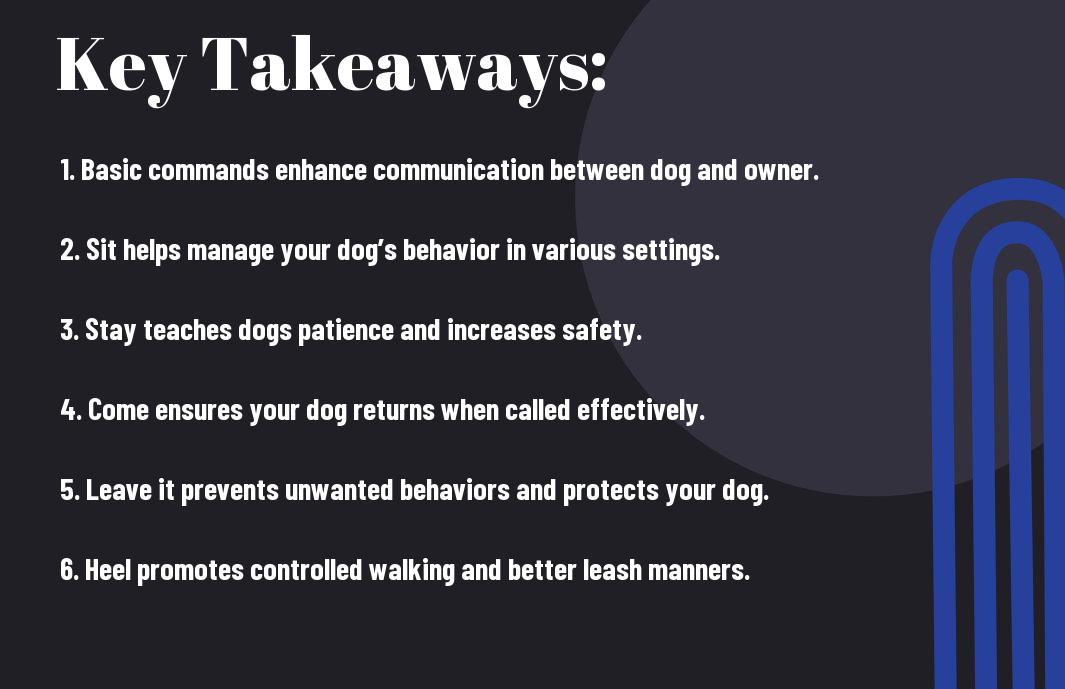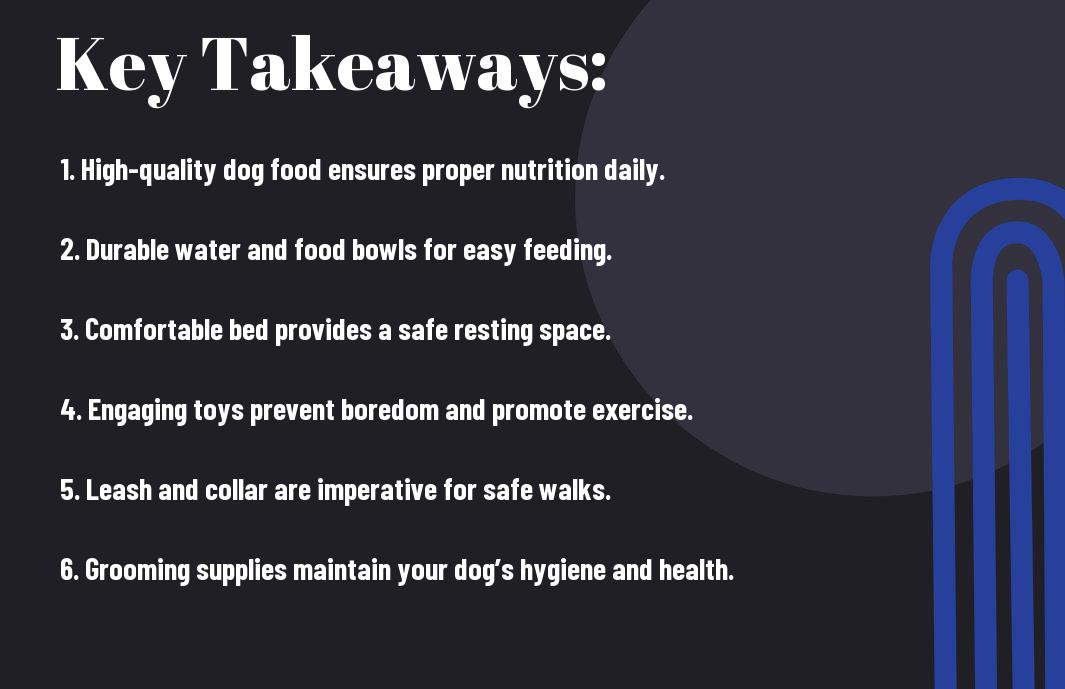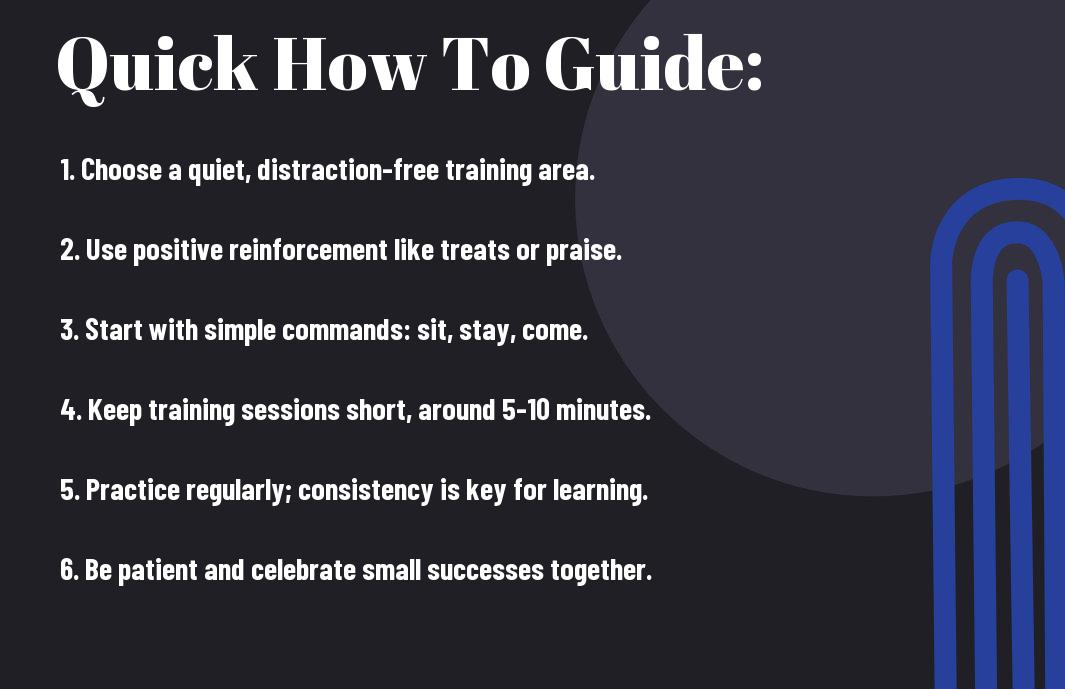Commands can transform your relationship with your dog, ensuring better communication and safety. By teaching your furry friend these 10 necessary commands, you’ll not only enhance their behavior but also foster a sense of security in various situations. Commands like sit and stay can prevent potential dangers, while come ensures they return to you when needed. Whether you’re a new dog owner or looking to reinforce basic training, mastering these commands will empower you and your pup for a joyful, obedient partnership.

Sit
For any dog owner, teaching your dog the command to “sit” is one of the first and most foundational skills you can introduce. This command not only helps you establish control over your pet but also lays the groundwork for other necessary commands. Essentially, you can reinforce your dog’s understanding of obedience while also promoting a positive bond between you and your four-legged friend. A dog that understands “sit” will be easier to manage in various situations, such as greeting guests or waiting for food.
Basic Obedience
If you want your dog to learn “sit,” it’s best to begin in a quiet environment with minimal distractions. Start by holding your dog’s favorite treat close to their nose to get their attention. Gradually lift the treat upwards, allowing your dog’s head to follow the treat, which naturally encourages their backend to lower to the ground. Once they are in the sitting position, immediately reinforce this behavior by praising them and giving them the treat. This will help them associate the action with a positive outcome.
If you practice consistently, your dog will learn to associate the command “sit” with the behavior itself. As they start responding to your command without needing a treat as a prompt, you can gradually phase out the treats, replacing them with verbal praises or petting as a reward. With time and repetition, “sit” can become a natural response for your dog.
Calm Behavior
Little do many dog owners know that teaching “sit” goes beyond just having your dog obey orders; it also promotes calm behavior. When your dog sits, they are encouraged to reduce their excitement and remain still, which can be particularly beneficial in busy settings or during training sessions. By associating the “sit” command with calmness, you are directly shaping their ability to take a breather and then engage in more focused interactions with you and their environment.
To capitalize on this benefit, make sure you are patient when teaching the “sit” command. Use positive reinforcement and ensure your dog’s environment supports calmness during practice. This will nurture not only their obedience but also their overall behavioral discipline, leading to a more manageable and well-rounded dog. After mastering “sit,” you may find it easier to introduce more complex commands, ultimately enhancing your dog’s training experience and strengthening your bond.
Stay
While teaching your dog the command “stay” can be a game changer in your training routine, it’s also one of the most important lessons for keeping your pup safe. A well-executed stay command can prevent your dog from wandering into dangerous situations, such as running into traffic or approaching an aggressive animal. It also gives you more control in various environments, from busy parks to crowded streets, ensuring that your dog remains calm and composed.
Stay in place
Some dogs may initially struggle with understanding the concept of staying in one spot, but through consistent practice and positive reinforcement, they can learn to master it. Start by asking your dog to sit or lie down and use a firm voice to say “stay.” Gradually increase the distance between you and your dog, rewarding them with treats or praise when they maintain their position. This command helps in teaching your dog patience and can be particularly useful for managing their behavior around guests or other distractions.
As your dog becomes more proficient at staying in place, you can introduce distractions to test their training. This could include tossing a toy nearby or having someone walk past. Your dog must learn to remain focused despite these temptations. Offering treats or enthusiastic praise will motivate your pup to stay put, reinforcing the connection between their good behavior and your approval.
Delayed command
Stay is not just about teaching your dog to halt their movement; it is also about helping them understand the importance of waiting for your cue before they can release or act. This aspect is often referred to as the delayed command. It goes beyond the basic “stay” and encourages your dog to maintain discipline and restraint even when they might feel the urge to break free from the command.
Place your dog in a stay position and gradually increase the time before you give them the release command. This can start as just a few seconds, eventually building up to several minutes. Be sure to keep your dog engaged during this time, using plenty of praise and treats when they remain calm and obedient. Implementing the delayed command not only enhances your dog’s ability to control impulses but can also serve as an excellent exercise for their mental stimulation.
Come
Unlike many commands that simply prompt your dog to follow a cue, the “Come” command, also known as the recall command, is a lifesaver. Teaching your dog to come when called can significantly enhance their safety and give you peace of mind when they’re off-leash or in an open area. A strong recall builds a bond of trust between you and your dog, ensuring they return to you promptly, regardless of distractions around them.
Recall Command
On the path to a reliable recall command, it’s necessary to create positive associations with the act of coming to you. Start training in a controlled environment, such as your backyard or a quiet park, where distractions are minimal. Use treats or your dog’s favorite toy as incentives. Call your dog in an enthusiastic tone, rewarding them generously when they respond. This helps reinforce the behavior you want and makes them excited to come to you every time.
On the other hand, consistency is key. Practice regularly and gradually increase distractions while ensuring that your dog always gets rewarded for coming back. This consists of using the same tone and command each time, so your dog learns to recognize it. If your dog doesn’t respond at first, avoid showing frustration; instead, encourage them with a high-energy voice and even use hand signals to guide them back.
Safety Measure
To ensure that the “Come” command is effective, it’s imperative to incorporate safety measures into your training routine. This involves understanding that not all environments are suitable for off-leash activities initially. Consider using a long leash or a harness to allow your dog some freedom while maintaining control. This will give you the ability to correct them if they become distracted or tempted to chase after something that could put them in danger.
For instance, utilizing a long leash can help you practice the recall command without losing control. It keeps your dog safe while still providing them room to explore. You can also introduce practice scenarios that mimic real-life situations—such as distractions like other animals or people nearby—that your dog may encounter. By reinforcing the recall command during these practice sessions, you build a solid foundation that prepares them for off-leash moments. Ultimately, the “Come” command serves not just as a simple training exercise, but as a key component in protecting your dog and allowing them the freedom to roam safely in various environments.
Down
All dog owners should aim to teach their pets the command “Down.” This command is important for promoting good behavior and helping your dog learn to settle in various situations. “Down” not only establishes a position for your dog but also creates an opportunity for them to relax and engage positively with their environment. When taught effectively, the “Down” command can prevent hyperactivity and ensure your dog feels at ease, thereby enhancing safety during public outings and social events.
Laying position
Down is a fundamental command that teaches your dog to lie down with their belly on the ground. To begin, you can use a treat or your dog’s favorite toy to guide them into the desired position. Hold the treat near their nose, then move it slowly toward the ground. As your dog follows, they will naturally drop into a lying position. Be consistent with your tone and don’t forget to praise your dog as soon as they comply; this will reinforce the behavior you’re teaching.
Once your dog understands the motion, integrate the verbal command “Down.” Consistency is key, so practice this in different locations and environments to help your dog generalize the command. With time and practice, your dog will learn to respond to “Down” reliably, providing you with valuable control in various situations.
Relaxed state
An additional benefit of teaching your dog the “Down” command is promoting their relaxed state. When your dog is lying down, they are typically more at ease and calm. This position encourages them to settle, making it beneficial for both indoor and outdoor settings, particularly in stimulating environments. As a responsible dog owner, being able to command your dog to lie down can significantly reduce anxiety for your pet and allow you to manage their behavior more effectively.
It’s also important to note that a relaxed dog is less likely to engage in undesirable behaviors, such as jumping or barking. By encouraging this calm posture, you not only contribute to the overall well-being of your pet but also to the comfort of those around you. A well-practiced “Down” command can become a valuable tool in your training arsenal, promoting a peaceful coexistence in various social situations.

Leave it
Despite the temptation your dog might feel when they come across something enticing, teaching them the command “leave it” is crucial for their safety and your peace of mind. This command helps in preventing dogs from picking up harmful objects, such as spoiled food or dangerous items like glass shards. Whether it is while on a walk or during playtime at home, being able to enforce this command can protect your furry friend from potential hazards that could lead to serious health issues.
Avoid distractions
Even the most focused dogs can become easily distracted by interesting smells, sounds, or sights. To effectively teach “leave it,” set your training sessions in a calm environment free from distractions. Start by practicing this command in a quiet room before gradually introducing more stimulating situations, such as outdoor areas or pet-friendly environments. This will help your dog understand that regardless of external stimuli, their attention should remain on you when you give the command.
Focus on owner
There’s a strong emphasis on getting your dog to focus on you rather than the distractions around them. To foster this bond, use treats or toys as rewards for when they successfully obey the command. This will motivate them to pay attention and lock their gaze on you, creating a positive association with the behavior you want to encourage. As they grasp the command, progressively increase the distance between the temptations and your dog to strengthen their self-control.
Avoid expecting immediate results—training takes time and patience. Celebrating small successes, like your dog making eye contact with you instead of the item they want to explore, is important. With consistent practice, your dog can learn to prioritize your commands, ensuring they safely navigate their environments while also improving your overall relationship.
Drop It
To ensure your dog is well-behaved and safe, teaching them the “drop it” command is vital. This command helps you communicate effectively with your pet when they have something in their mouth that they shouldn’t. It fosters a sense of trust and understanding between you and your dog, allowing for a more enjoyable time together. Once your dog masters this command, you will have greater control over their behavior and can manage situations where they may pick up undesirable or dangerous items.
Release Objects
Objects can pose various risks, from common household items to outdoor hazards. Teaching your dog to “drop it” ensures that when they pick up anything that could cause harm, they know to release it immediately upon your request. This is particularly useful for preventing your dog from swallowing potentially hazardous objects, like small toys, pieces of food that may not be safe, or even trash. You’ll find that your dog’s understanding of this command not only makes your daily activities smoother but also instills a sense of discipline.
Prevents Choking
Little things can lead to serious consequences when it comes to your dog’s safety. One of the most alarming risks is choking. By teaching your dog the “drop it” command, you can help prevent choking incidents by ensuring they release objects that could block their airway. This practice allows you to intervene quickly if your dog happens to grab something dangerous or too large to chew safely.
Any dog owner must take choking hazards seriously, as they can lead to suffocation or serious injury. Incorporating the “drop it” command into your training routine can greatly reduce these risks. When your dog understands that they should drop items upon your command, you’re not merely teaching a trick; you’re equipping yourself with a valuable tool for ensuring your dog’s safety and well-being. Your dog’s life—and yours—will be much smoother with this command in their repertoire.
Heel
Now, teaching your dog to “heel” is an important part of training that will enhance your walking experience with your furry friend. This command instructs your dog to walk closely beside you, which not only helps maintain control but also ensures safety during walks. When your dog is in the heel position, it is less likely to pull on the leash, bark at passersby, or dart into the street, making your outings much more enjoyable.
Walking beside
The first step in teaching your dog to heel is getting them accustomed to walking beside you. Start by using a command word like “heel” while holding a treat in your hand at your side. As you walk, encourage your dog to stay close to you by rewarding them with praise and treats whenever they are in the correct position. This kind of positive reinforcement will help your dog associate being by your side with good things. If they begin to stray away, gently guide them back to your side until they understand what is expected.
Loose leash
Clearly, having your dog heel means they should walk on a loose leash rather than pulling aggressively ahead. A loose leash indicates that you are in control and that your dog is attentive to you rather than distracted by other stimuli. Training your dog to walk on a loose leash takes practice and patience. Start by using your preferred collar or harness and allow your dog to sniff and explore while you walk together. When they start to pull, immediately stop walking, and wait for them to return to your side before continuing. This teaches them that pulling won’t get them anywhere.
Walking your dog on a loose leash is important for a pleasant walking experience. In addition to making walks more enjoyable, it also keeps your dog safe from potential hazards like traffic or other dogs. You can further reinforce this behavior by practicing regularly in low-distraction environments before attempting to walk in more stimulating areas. With time and consistency, your dog will learn that staying close to you yields many benefits, leading to a happier and safer walking routine.
No
Not every behavior exhibited by your dog is welcome, and that’s where the command “No” comes into play. Teaching your dog to understand this simple word can significantly enhance the safety and enjoyment of both your lives. When you effectively communicate what is unacceptable, you guide your dog toward better choices, which is vital for a harmonious relationship.
Discouraging behavior
An effective “No” command serves as a tool for discouraging behavior that you don’t want your dog to engage in, such as jumping on guests, chewing furniture, or barking excessively. It’s important to deliver the command firmly but calmly, so your dog recognizes it as a signal to stop what they are doing. Consistent reinforcement will help your dog associate the command with stopping undesirable actions, thereby creating a clear line between acceptable and unacceptable behavior.
Boundaries established
There’s a significant difference between a dog that behaves according to your expectations and one that is allowed to act freely without guidance. Establishing boundaries with the “No” command fosters a sense of safety for both you and your pet. When boundaries are established, your dog learns that there are limits to their freedom, which can prevent dangerous situations, such as running into traffic or stealing food from guests.
Discouraging unwanted behavior is not just about saying “No.” By pairing this command with positive reinforcement strategies, you can make your dog more inclined to listen and follow your lead. Each time your dog refrains from the undesirable behavior following your command, it’s vital to reward them with praise or a treat. This helps solidify the understanding that stopping at “No” is not just a command, but a way to earn your approval and affection. As a result, you create an environment where your dog feels secure and knows their boundaries, leading to a happier, more well-adjusted pet.

Wait
Keep in mind that teaching your dog the command “wait” can be incredibly beneficial for both you and your furry friend. This command serves as a means of gaining control in various situations where a temporary pause is necessary, whether you’re preparing to open the door, getting ready to cross the street, or simply asking your dog to hold their position during meal times. Consistently reinforcing this command can enhance your dog’s self-discipline and obedience, making daily activities more manageable and safe.
Temporary pause
Now, when you teach your dog to wait, you’re necessaryly instilling a sense of patience. Start by asking your dog to sit, and then clearly say “wait” while placing your hand in front of you, palm facing them. Gradually increase the duration before you reward your dog with a treat or praise. This temporary pause can be particularly valuable in preventing impulsive behaviors, such as bolting out the door or lunging at distractions.
Control excitement
Little by little, teaching “wait” can help you control your dog’s excitement in scenarios that might otherwise lead to reckless behavior. For instance, when greeting guests or during playtime, a dog that understands the “wait” command is less likely to jump on people or become overly aggressive during toy retrieval. By implementing this command, you can create a more relaxed environment for both your dog and your visitors.
A well-timed “wait” can be the key to maintaining an atmosphere of calm. Utilizing this command effectively can prevent your dog from engaging in undesirable behaviors that stem from excessive enthusiasm. Not only does this command support better control of your dog’s excitement, but it also enhances your dog’s overall understanding of boundaries. Implementing this command will foster a trusting relationship between you and your pet, leading to a well-behaved and composed companion.
Off
Once again, one of the simplest commands that can greatly enhance your relationship with your dog is “off”. This command is particularly vital for maintaining a comfortable and safe environment, both for you and your visitors. Teaching your dog to be responsive to “off” can prevent unwanted behaviors and promote good manners.
Jumping Prevention
An over-excited dog often expresses their joy and enthusiasm by jumping on people. This can be seen as an expression of affection, but it can also be overwhelming for your guests and may lead to unwanted accidents, especially with young children or elderly individuals. By teaching your dog the “off” command, you can provide a clear signal that jumping is not acceptable, helping to reinforce more appropriate greetings—like sitting calmly for attention instead.
Incorporating the “off” command into your dog’s training routine can also reduce anxiety and create more controlled social interactions. When your dog learns that jumping on people is not tolerated, they can redirect their energy into more positive behaviors such as sitting or lying down. This means you can entertain guests without worry, creating a more enjoyable experience for everyone involved.
Personal Space
If you have a sociable dog, they may not always understand the concept of personal space. Both dogs and humans require their own boundaries, which should be respected to ensure everyone’s comfort. The “off” command provides your dog with clear boundaries about when to give you space, whether you are eating, relaxing, or engaging with others. Learning to respect personal space helps cultivate a respectful relationship between you and your furry friend.
Space is an important aspect of training your dog to respect the areas that you designate as off-limits, such as a kitchen counter or a comfortable spot on the couch. By using the “off” command, you can prevent your dog from monopolizing your personal space, which fosters a sense of security for you and a clear understanding for your pet of acceptable behaviors. This not only leads to a harmonious living arrangement but also encourages your dog to remain calm and collected during everyday activities.
Final Words
Now that you are familiar with the 10 imperative commands every dog owner should teach, you can enhance not just your dog’s training but also your relationship with them. These commands will promote safety, good behavior, and overall well-being, allowing your dog to thrive in various situations. By consistently practicing these commands, you are setting your dog up for success and creating a strong foundation for future training.
Implementing these commands into your daily routine will provide your dog with structure and discipline, while also helping you to communicate more effectively. As you build your training regimen, be patient and celebrate the progress your dog makes, as every step forward counts. Investing time in training will undoubtedly yield rewards, enriching the bond you share with your furry companion.
Q: Why is it important to teach my dog basic commands?
A: Teaching basic commands helps establish effective communication between you and your dog. These commands can enhance safety, improve behavior, and strengthen your bond. Basic commands like ‘sit,’ ‘stay,’ and ‘come’ can help control your dog in various situations, making outings more manageable and enjoyable. Furthermore, reinforcement through training can boost your dog’s confidence and mental stimulation.
Q: What are the top 10 crucial commands I should teach my dog, and why?
A: The top 10 crucial commands to teach your dog include:
- ‘Sit’ – It helps your dog learn to be calm and patient.
- ‘Stay’ – A vital command for keeping your dog safe in potentially hazardous situations.
- ‘Come’ – Ensures your dog returns to you when called, enhancing safety during walks.
- ‘Down’ – Encourages your dog to settle down, useful for managing energy levels.
- ‘Leave it’ – Teaches your dog to ignore unwanted items or distractions.
- ‘Heel’ – Helps your dog walk nicely on a leash without pulling.
- ‘Drop it’ – A command for getting your dog to release items safely.
- ‘No’ – Communicates disapproval of undesirable behaviors immediately.
- ‘Where’s your toy?’ – A fun way to engage your dog and encourage play.
- ‘Wait’ – Teaches patience in various situations, especially at doorways or during feeding.
These commands lay the foundation for effective training and allow you to manage different situations more easily.
Q: How can I effectively teach these commands to my dog?
A: To effectively teach commands to your dog, use positive reinforcement methods. Begin with a quiet environment to minimize distractions. Use treats, praise, or toys as rewards when your dog successfully follows a command. Break down each command into simple steps, ensuring your dog understands each part before progressing. Practice in short sessions to keep your dog engaged and focused, gradually increasing difficulty as your dog becomes more proficient. Consistency is key; use the same command words and gestures every time to minimize confusion.










